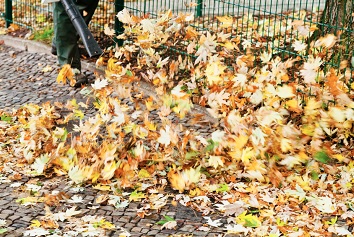Leaf blowers aren’t just for autumn—you’ll see them in use throughout the year. They can be used to blow the grass off your mower, to blow cut grass off sidewalks and paths … they have essentially replaced brooms and rakes for many tasks. They may be time-savers, but leaf blowers also pose hazards.

Make sure workers are aware of the hazards of this labor-saving device.
Leaf Blowers
Most people think of noise when they think of leaf blowers, but noise is not the only hazard leaf blowers pose. Users should be aware of:
Dust. Leaf blowers generate large amounts of airborne dust, which can be hazardous.
- To control exposure to nuisance dusts, wear a dust mask.
- To prevent eye injuries, wear safety goggles.
- To prevent lung injury, do not use a leaf blower to clean up gravel or gravel dust, construction dirt, plaster dust, cement and concrete dust, garden topsoil, or any other dust that could contain crystalline silica or hazardous materials.
- To prevent injuries to bystanders, make sure that no one is within 50 feet of the blower while it is operating.
- Reduce the amount of dust generated by using nozzle extensions and by holding the leaf blower at the height that generates the least dust.
Exhaust fumes. The two-stroke or four-stroke engines used in gasoline-powered leaf blowers generate more carbon monoxide and other exhaust gases than a car. Because of this, leaf blowers must not be used indoors or in poorly ventilated areas.
Fire hazards. Hot engines, engine sparks, and flammable vapors don’t mix.
- Don’t refill an engine that is running or still hot.
- If you spill gasoline when refueling, wipe it up, and put the rag you use in a metal can with a lid.
- Don’t start the blower in the spot where you fueled it; walk at least 10 feet away.
Noise. Current-generation leaf blowers are quieter than older ones, but users should still protect themselves and others from blower noise.
- Wear hearing protection.
- Don’t use a higher throttle speed if a lower speed will do.
- Nozzle attachments can be used to reduce sound.
- Be aware of reverberation effects (which increase noise levels) when the blower is used around buildings.
- Make sure that the blower muffler is functioning, the air filter is in good condition, and air intakes are clear in order to keep sound levels down. Check the condition of the leaf blower muffler, air intakes, and air filter to make sure they’re in good operating condition.
